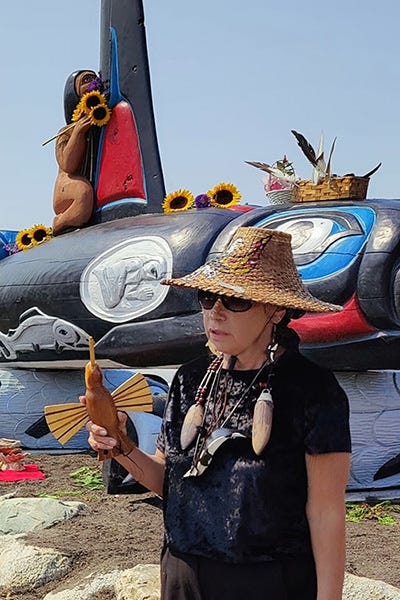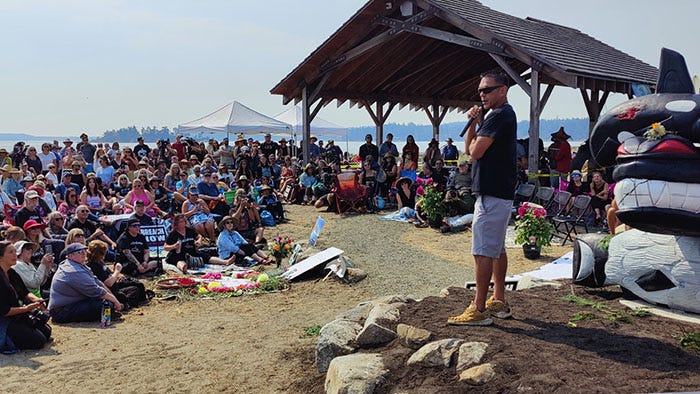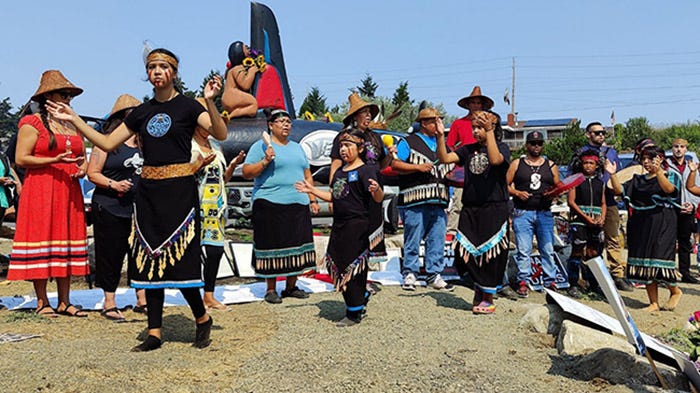Sk’aliCh’elh-tenaut celebration is a call to action
A celebration of life for Southern Resident orca Sk’aliCh’elh-tenaut was a call to action as well as a remembrance.

The celebration of life for Sk’aliCh’elh-tenaut (Ska-lee-CHUCK-ten-aught) on Aug. 27 at Jackson Beach on San Juan Island’s Griffin Bay was as much a call to action as a remembrance. The Southern Resident orca — also known as Tokitae and Lolita — died Aug. 18 at the Miami Seaquarium after 53 years in captivity, even as plans were being made to return her home to the Salish Sea.

Hundreds of people attended the celebration of life — and signed petitions for the removal of dams, particularly on the Snake River, and heard presentations about humans’ responsibility to protect salmon habitat.
Messages on signs and clothing called for all captive orcas to be freed. “They don’t belong to us,” one speaker said. “They belong here, where their ancestors are from.”
A dinner of cooked crab and salmon provided a reminder of what’s at stake for all who depend on salmon — Indigenous cultures, native and non-native peoples, orcas — if humankind fails to protect the environment that sustains it.
As sage burned in an abalone shell, Jay Julius of the Lummi Nation placed eagle feathers on an orca story pole. Ceremonies began with a welcome by Jess Newley of Friends of the San Juans.
Julius explained the significance of the story pole, carved by Jewell James and the House of Tears Carvers to depict the orca Tahlequah carrying her dead calf in 2018. The pole has come to symbolize the survival challenges faced by all orcas.
Poets and artists shared their tributes, along with officials including Rep. Deb Lekanoff (D-Bow) and advocates Kelley Balcomb-Bartok, a founder of the Tokitae Foundation which became the Orca Conservancy, and Howard Garrett, who heads the Orca Network.
Al Scott Johnnie, former cultural director at the Lummi Nation, spoke on the history of the Lummi, or Lhaq’temish, people and their ties to the San Juan Islands, noting that San Juan Island is the Lhaq’temish people’s place of origin.
Young dancers with the Lummi Nation Blackhawk Singers, wearing woven cedar headbands and dresses fringed with carved cedar paddles, and other singers and drummers performed traditional songs.


— Reporting and photos by Richard Arlin Walker
Subscribe: Sign up for our weekly newsletter for all the news, delivered.
Comment: We welcome letters to the editor responding to or amplifying subjects addressed in the Salish Current.
Contribute: To contribute a Community Voices essay, email your subject proposal to Managing Editor Mike Sato (msato@rockisland.com) and he will respond with guidelines.
Donate: Support nonpartisan, fact-based, no-paywall local journalism from the Salish Current.
written by:
Richard Arlin Walker is a journalist and mariner living in Anacortes. He worked for 33 years as a reporter and editor in four states and is currently a regular contributor to ICT, Hamiinat magazine and other publications. He is the author of two local-history books ("Roche Harbor" and "Point No Point") and two books of poetry. When he is not writing, he is a deckhand aboard the Guemes Island Ferry.




